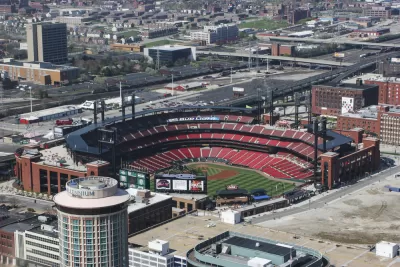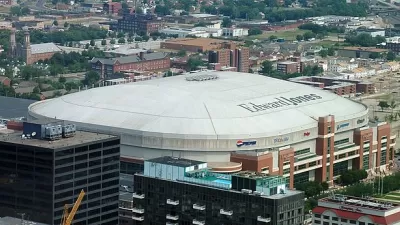Backers hoped a soccer stadium would ease the pain of losing the St. Louis Rams to Los Angeles in 2016. Now St. Louis sports fans will have to go back to the drawing board.

Danny Wicentowski reports from election night in St. Louis, where a controversial proposal to build a stadium to house a Major League Soccer (MLS) team failed to receive the necessary voter support.
As election night dragged on, the once-boisterous crowd of soccer supporters in the Union Station Hotel's Regency Ballroom began to grow quiet, their excitement replaced by the sullen resignation of sports fans watching their team lose the biggest game of the season. Only, in this case, it wasn't just a game.
The prospect of bringing an MLS team to St. Louis was meant, in small part, to assuage the pain of losing the St. Louis Rams NFL team in 2016.
Ultimately, 30 percent of city voters came out — a surprisingly high percentage (higher than the 28 percent who voted in the hotly contested March primary). And 30,603 voted no on Prop 2. Just 3,300 votes separated the soccer fans from victory.
Jim Kavanaugh, one of the primary investors in the stadium plan, is quoted extensively throughout the story. According to Kavanaugh, county officials never bought in to the idea for the stadium downtown, and city residents would have been left paying the bill for a regional attraction.
The St. Louis Post-Dispatch also shared this television news broadcast from the local Fox affiliate, reporting the news of the stadium proposal's defeat.
FULL STORY: Soccer Supporters Mourn Defeat of MLS Stadium Plan in St. Louis

Planetizen Federal Action Tracker
A weekly monitor of how Trump’s orders and actions are impacting planners and planning in America.

Chicago’s Ghost Rails
Just beneath the surface of the modern city lie the remnants of its expansive early 20th-century streetcar system.

San Antonio and Austin are Fusing Into one Massive Megaregion
The region spanning the two central Texas cities is growing fast, posing challenges for local infrastructure and water supplies.

Since Zion's Shuttles Went Electric “The Smog is Gone”
Visitors to Zion National Park can enjoy the canyon via the nation’s first fully electric park shuttle system.

Trump Distributing DOT Safety Funds at 1/10 Rate of Biden
Funds for Safe Streets and other transportation safety and equity programs are being held up by administrative reviews and conflicts with the Trump administration’s priorities.

German Cities Subsidize Taxis for Women Amid Wave of Violence
Free or low-cost taxi rides can help women navigate cities more safely, but critics say the programs don't address the root causes of violence against women.
Urban Design for Planners 1: Software Tools
This six-course series explores essential urban design concepts using open source software and equips planners with the tools they need to participate fully in the urban design process.
Planning for Universal Design
Learn the tools for implementing Universal Design in planning regulations.
planning NEXT
Appalachian Highlands Housing Partners
Mpact (founded as Rail~Volution)
City of Camden Redevelopment Agency
City of Astoria
City of Portland
City of Laramie



























